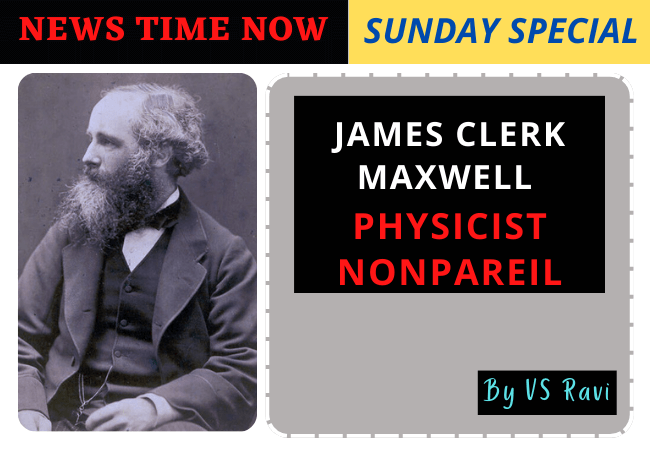James Clerk Maxwell, the man who discovered Electromagnetism one of the four fundamental forces of the Universe (the other three being Gravity, Strong Nuclear Force and Weak Force) was born in 1831 in Edinburgh, to John Clerk Maxwell and Frances Kay. When Maxwell’ mother died of cancer in 1839, the tender hearted eight-year-old James reportedly cried, “Oh, I’m so glad! Now she’ll have no more pain.” His father was the landed proprietor, of an estate as well as a lawyer and a part-time inventor.
Maxwell’s childhood was something of a model for a future scientist. He was close to his father, was endowed with an exceptional memory, and had a fascination with mechanical toys which he retained all his life. He won the mathematics medal at Edinburgh Academy in 1841 and soon thereafter began accompanying his father to meetings of the Edinburgh Royal Society.
His precocity was such that he was only fourteen when the Society published his paper on drawing ellipse using pins and thread.
The Electromagnetic laws, being mathematical in content involve complex differential equations and unify electricity and magnetism as a single, measurable force. In addition, they suggest-a fact obviously of great consequence —that light is part of this electromagnetic field and the visible portion of a much broader spectrum. For all this, as well as for his work on the dynamics of gases, Maxwell most clearly prefigures twentieth-century physics. His research led directly to the technology associated with radio and television, and some of his work paved the way for Cybernetics.
After attending the University of Edinburgh beginning in 1847, Maxwell entered Trinity College, Cambridge, three years later.
He graduated in 1854 and returned to teach at Marischal College in Aberdeen, Scotland. In 1857 he studied the rings of Saturn, describing them in a way which was corroborated, over a century later, by the findings of the Voyager space probe.
Maxwell spent the most fruitful decade of his life, in King’s College, London, from 1860. He formulated a theory of colour in 1855. In 1861 he created the first colour photograph—of the Scottish tartan ribbon. That year he was elected to the Royal Society. A decade later he organised England’s prestigious Cavendish Laboratory, in Cambridge university and became its first director. As of 2019, 30 Cavendish researchers have won Nobel Prizes. Notable discoveries to have occurred at the Cavendish Laboratory include the discovery of the electron, neutron, and structure of DNA: Between 1884 and 1919 an earnest looking Professor along with a bunch of talented research students in a rather underfunded Cavendish laboratory in Cambridge split the atom and started a new branch of science known as particle Physics. The Professor was JJ Thomson, the discoverer of electron for which he got the Nobel Prize in 1906. What followed subsequently was not anticipated —seven of JJ’s research students went on to win the Nobel Prize in Physics and Chemistry, a feat unrivalled by any other Professor. One would wonder what was happening at the Cavendish Laboratory under JJ that would secure such a roll of honour. Was it just a quirk of fate that some of the best minds in Physics congregated at Cavendish during the time or was it JJ’s ability to make intelligent men do brilliant work.JJ Thomson is the only Professor who changed scientific history not just through individual brilliance , but through careful nurture of extraordinary minds. Had the Nobel Prizes been awarded in the nineteenth century, Maxwell would probably been given the Nobel prize three times !
Maxwell’s work on electromagnetism derives from his predecessor Michael Faraday and represents a quantification of it. Neither Faraday nor Lord Kelvin, Maxwell’s contemporary, could easily visualise how electricity works unless they had a mechanical model of some sort. In Faraday’s terms, for example, tubelike “lines of force” explain the apparent “action at a distance” in magnetic phenomena. Much as Isaac Newton had provided equations to explain the mechanics of moving bodies, Maxwell replaced a machine-like model with one which computed and predicted electrical phenomena. Electricity is no longer thought of as gadgetry that can be pictured in the mind.
As early as 1855 Maxwell, who was younger to Faraday by 40 years had attempted to understand how Faraday’s ideas might be given mathematical form. Maxwell’s, famous account ” A Dynamical Theory of the Electromagnetic Field was read before a largely perplexed Royal Society in 1864. Here he brought forth, for the first time the equations which comprise the basic laws of electromagnetism. They show how an electric charge radiates waves through space at various definite frequencies that determine the charge’s place in the electromagnetic spectrum. Maxwell was able to predict the existence of the entire electromagnetic spectrum–now understood to include radio waves, microwaves, infrared waves, ultraviolet waves, X rays and gamma rays.
But, in addition, Maxwell’s equations deliver their most profound consequence by giving the speed of electricity at about 30000 km/sec – quite close to the experimentally derived speed of light, ” The velocity is so nearly that of light ” wrote Maxwell ” that it seems we have strong reason to conclude that light itself… is an electromagnetic disturbance in the form of waves propagated through the electromagnetic field according electromagnetic laws”.
The full significance of Maxwell’s work, which was expanded as “Treatise on Electricity and Magnetism” in 1873, was not immediately grasped. This was largely because an understanding of the atomic nature of electromagnetism was not yet at hand.
During the 1860s Maxwell also took up the problem of quantifying the composition of gases and the physical properties of molecules. In general, Maxwell describes mathematically the movement of molecules in a gas at a given temperature. Maxwell first considered the problem in the 1850s while studying the rings of Saturn, and soon other physicists had developed the doctrines of the conservation of energy and entropy —the laws of thermodynamics. In addition, a mass of experimental material on the behaviour of gases made possible further theoretical advances.
In1860 Maxwell hit upon the notion of using statistics to describe the way gas molecules behave. With his 1867 paper “On the Dynamical Theory of Gases” the properties of known gases were shown to correspond with those predicted by theory, and in 1870 Maxwell published “The theory of heat” which became a cornerstone of the nineteenth century view of matter according to wrote Maxwell’s biographer Ivan Tolstoy. Tolstoy also opined that where Maxwell’s theory of electromagnetism gives a true measure of his genius, his work on molecular theory is a monument to his profound insight into physics”.
One final contribution of Maxwell needs to be noted for his contemporary interest. His paper”; On Governors ” is one of the foundations of the theory of feedback established in the mid twentieth century, most closely with Norbert Weiner ‘s Cybernetics .
About 1880 Herman Von Boltzmann an admirer of Maxwell, discussed the possibility of confirming his equations with a student, Heinrich Hertz. In 1888 Hertz performed a series of experiments which produced and measured electromagnetic waves and showed how they behaved like light. Thereafter, Maxwell’s reputation continued to grow.
Richard Feynman, one of the greatest physicists of the 20th century was of the view that the most significant event in physics of the nineteenth century was Maxwell’s discovery of the laws of electrodynamics
In fact many physicists regard both Maxwell and Faraday as the two 19th-century scientists having the greatest influence on 20th-century physics.
In the world of physics Maxwell is ranked alongside, Copernicus, Newton, Einstein, Galileo, and Faraday.


















































